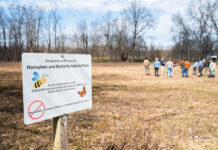I had an e-mail message the other day from Dr. Cameron Thraen, agricultural economist for dairy policy, Ohio State University Extension, concerning the present situation within the Ohio dairy industry. Thraen gave some interesting insight about dairy policy and market forces in response to a question from a county agent about milk prices.
The county agent was asking how dairy managers reconcile the large number of large dairy herds coming on line in Northwest Ohio while people are saying there are too many cows and too much milk in the country.
Thraen stated that although milk price is low, so are grain and forage prices, so the profit margin on dairy farms of all sizes when considered as one group is “very good. If we have a bad weather year in the grain sector or for forages, then the real pain will begin.”
Thraen goes on to say that dairy managers with top management skills and the added advantage of “appropriate size” will continue to do well as long as grain and forage prices stay low. In other words, well-managed larger herds are profitable at current feed and milk prices and should continue to be, even though most smaller herds must subsidize farm income with non-farm income in order to stay in business.
Thraen said that since manufacturing milk prices are basically at the floor support price of $9.90 per cwt. (which translates into an all-milk price of about $12.50) and will probably stay there for the foreseeable future, the market is not responding by reducing milk production.
I decided to take a look at our Extension Dairy Enterprise Budgets and compare them to our “Economies of Scale Dairy Enterprise Budgets” for 2000 and find out what the economies of scale really are for large herds.
I found that the following assumptions were made when compiling these budgets:
1. Receipts per cow are the same for all three sizes of operation.
2. Variable costs per cow, excluding labor, are the same for all three sizes of operation.
3. Buildings, facilities and equipment are all newly purchased.
4. Labor costs do not include labor for crop production.
5. Herd size is the number of milking cows at any one time. The 100, 600 and 2400 cow herds are made up of 122, 732, and 2928 cows and dry cows respectively.
6. Milk price is $13/cwt
REVENUE, COSTS OF PRODUCTION AND RETURNS FOR THREE DIFFERENT SIZED DAIRY HERDS COWS AND REPLACEMENTS
Herd Size
Milking Cows 100 600 2400
Milking + Dry Cows 122 732 2928
TOTAL OPERATION
Receipts $363,877 $2,183,263 $8,733,053 (Includes milk, heifers sold, bull calves, cull cows)
Variable Costs
Feed 160,308 961,848 3,847,392
Other 89,022 643,930 2,370,761
Total 249,330 1,605,778 6,218,153
Fixed Costs 143,303 438,729 1,572,108
Total Costs 392,632 2,044,50 7,790,261
Return Above Variable Costs 114,548 577,485 2,514,900
Return Above Total Costs -28,755 138,756 942,792
PER COW
Receipts/Cow 2,983 2,983 2,983
Variable Costs/Cow 2,044 2,194 2,124
Fixed Costs/Cow 1,175 599 537
Total Costs/Cow 3,218 2,793 2,661
Return Above Variable Costs/Cow 939 789 859
Return Above Total Costs/Cow -236 190 322
Variable Costs/cwt Milk 9.73 10.45 10.11
Fixed Costs/cwt Milk 5.59 2.85 2.56
Total Costs/cwt Milk 15.33 13.30 12.67
So, why the differences in costs of production and returns above total costs between herds of 100, 600 and 2,400 cows? It isn’t in labor costs. All employees in all herds are working 2,500 hours per full time employee per year and are paid $10 an hour. The 100-cow herd has 1.67 full-time hired employees while the 600 cow herd has eight and the 2,400 cow herd has 25.25 employees.
The difference is in the overhead expenses. Depreciation, interest, repairs, taxes and insurance on machinery, equipment and facilities tell the tale. These annual costs on a per cow basis are as follows:
100 Cows 600 Cows 2400 Cows
Hired Labor Costs/Cow $158 $341 $256
Buildings and Facilities/Cow $503 $341 $321
Equipment/Cow 141 65 33
Total Facilities and Equip./Cow $644 $406 $354
I conclude from this discussion that larger herds are more profitable because they spread their fixed costs over more cows. These figures do not show any advantage in input purchasing power to larger herds, but I believe such advantages add to the profitability advantage of larger herds shown in these budgets.
Thraen said he expects the current price situation to restart the exodus of smaller herds which went on from 1993 to 1998. During that time Ohio lost 160,000 cows and approximately half of its dairy herds, but total milk production declined hardly at all, because more efficient herds continued to improve production per cow. We have too much milk because more efficient herds and larger herds can make money at the $9.90 support ($12.50 all-milk) price.
(The author is an agricultural extension agent in Columbiana County. Questions or comments can be sent in care of Farm and Dairy, P.O. Box 38, Salem, OH 44460.)











